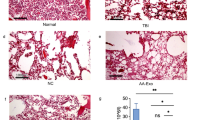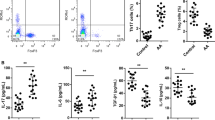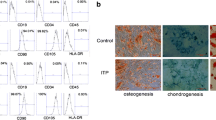Abstract
Bone marrow mesenchymal stem cells (BMSCs) are associated with immune thrombocytopenia (ITP), the underlying mechanism has not been fully elucidated. Here, we attempted to investigate whether BMSCs can regulate Th17/Treg imbalance in ITP through the exosome pathway. We first assessed the proportions of Th17 cells and Tregs in ITP patients, showing that ITP patients exhibited an evident imbalance of Th17/Treg. BMSCs-exosomes’ treatment significantly reduced Th17/Treg ratio in the CD4+ T cells of ITP patients. Moreover, miR-146a-5p was highly expressed in BMSCs-exosomes. The expression of miR-146a-5p was obviously increased in CD4+ T cells following the treatment of BMSCs-exosomes. BMSCs-exosomal miR-146a-5p silencing promoted the proportions of Th17 cells and repressed the proportions of Tregs in CD4+ T cells. In addition, miR-146a-5p directly interacted with IL-1R-associated kinase-1 (IRAK), and repressed IRAK1 expression. IRAK1 overexpression promoted Th17/Treg ratio in CD4+ T cells, which was abolished by BMSCs-exosomal miR-146a-5p. In conclusion, these findings demonstrate that BMSC-derived exosomal miR-146a-5p regulates Th17/Treg imbalance in ITP by repressing IRAK1 expression. Thus, this work suggests that BMSCs-exosomal miR-146a-5p may be a potential therapeutic target for ITP.








Similar content being viewed by others
References
Cooper N, Kruse A, Kruse C, Watson S, Morgan M, Provan D, et al. Immune thrombocytopenia (ITP) World Impact Survey (I-WISh): patient and physician perceptions of diagnosis, signs and symptoms, and treatment. Am J Hematol. 2020. https://doi.org/10.1002/ajh.26045.
Stasi R. Immune thrombocytopenia: pathophysiologic and clinical update. Semin Thromb Hemost. 2012;38(5):454–62. https://doi.org/10.1055/s-0032-1305780.
Audia S, Mahévas M, Samson M, Godeau B, Bonnotte B. Pathogenesis of immune thrombocytopenia. Autoimmun Rev. 2017;16(6):620–32. https://doi.org/10.1016/j.autrev.2017.04.012.
Kostic M, Zivkovic N, Cvetanovic A, Marjanović G. CD4 T cell phenotypes in the pathogenesis of immune thrombocytopenia. Cell Immunol. 2020;351:104096. https://doi.org/10.1016/j.cellimm.2020.104096.
Wang Q, Li J, Yu TS, Liu Y, Li K, Liu S, et al. Disrupted balance of CD4 T-cell subsets in bone marrow of patients with primary immune thrombocytopenia. Int J Biol Sci. 2019;15(13):2798–814. https://doi.org/10.7150/ijbs.33779.
Sehrawat S, Rouse BT. Interplay of regulatory T cell and Th17 cells during infectious diseases in humans and animals. Front Immunol. 2017;8:341. https://doi.org/10.3389/fimmu.2017.00341.
Jadidi-Niaragh F, Mirshafiey A. The deviated balance between regulatory T cell and Th17 in autoimmunity. Immunopharmacol Immunotoxicol. 2012;34(5):727–39. https://doi.org/10.3109/08923973.2011.619987.
Guo NH, Fu X, Zi FM, Song Y, Wang S, Cheng J. The potential therapeutic benefit of resveratrol on Th17/Treg imbalance in immune thrombocytopenic purpura. Int Immunopharmacol. 2019;73:181–92. https://doi.org/10.1016/j.intimp.2019.04.061.
Wu D, Liu Y, Pang N, Sun M, Wang X, Haridia Y, et al. PD-1/PD-L1 pathway activation restores the imbalance of Th1/Th2 and treg/Th17 cells subtypes in immune thrombocytopenic purpura patients. Medicine. 2019;98(43):e17608. https://doi.org/10.1097/md.0000000000017608.
Liu L, Hua M, Liu C, He N, Li Z, Ma D. The aberrant expression of microRNAs and correlations with T cell subsets in patients with immune thrombocytopenia. Oncotarget. 2016;7(47):76453–63. https://doi.org/10.18632/oncotarget.12949.
Zhang JM, Feng FE, Wang QM, Zhu XL, Fu HX, Xu LP, et al. Platelet-derived growth factor-BB protects mesenchymal stem cells (MSCs) derived from immune thrombocytopenia patients against apoptosis and senescence and maintains MSC-mediated immunosuppression. Stem Cells Transl Med. 2016;5(12):1631–43. https://doi.org/10.5966/sctm.2015-0360.
He Y, Xu LL, Feng FE, Wang QM, Zhu XL, Wang CC, et al. Mesenchymal stem cell deficiency influences megakaryocytopoiesis through the TNFAIP3/NF-κB/SMAD pathway in patients with immune thrombocytopenia. Br J Haematol. 2018;180(3):395–411. https://doi.org/10.1111/bjh.15034.
Rossi F, Tortora C, Palumbo G, Punzo F, Argenziano M, Casale M, et al. CB2 receptor stimulation and dexamethasone restore the anti-inflammatory and immune-regulatory properties of mesenchymal stromal cells of children with immune thrombocytopenia. Int J Mol Sci. 2019. https://doi.org/10.3390/ijms20051049.
Ma L, Zhou Z, Zhang D, Yang S, Wang J, Xue F, et al. Immunosuppressive function of mesenchymal stem cells from human umbilical cord matrix in immune thrombocytopenia patients. Thromb Haemost. 2012;107(5):937–50. https://doi.org/10.1160/th11-08-0596.
Zhang P, Zhang G, Liu X, Liu H, Yang P, Ma L. Mesenchymal stem cells improve platelet counts in mice with immune thrombocytopenia. J Cell Biochem. 2019. https://doi.org/10.1002/jcb.28405.
Yu B, Zhang X, Li X. Exosomes derived from mesenchymal stem cells. Int J Mol Sci. 2014;15(3):4142–57. https://doi.org/10.3390/ijms15034142.
Seo Y, Kim HS, Hong IS. Stem cell-derived extracellular vesicles as immunomodulatory therapeutics. Stem Cells Int. 2019;2019:5126156. https://doi.org/10.1155/2019/5126156.
Wang Y, Ma WQ, Zhu Y, Han XQ, Liu N. Exosomes derived from mesenchymal stromal cells pretreated with advanced glycation end product-bovine serum albumin inhibit calcification of vascular smooth muscle cells. Front Endocrinol. 2018;9:524. https://doi.org/10.3389/fendo.2018.00524.
Maitra U, Davis S, Reilly CM, Li L. Differential regulation of Foxp3 and IL-17 expression in CD4 T helper cells by IRAK-1. J Immunol. 2009;182(9):5763–9. https://doi.org/10.4049/jimmunol.0900124.
Stürner KH, Verse N, Yousef S, Martin R, Sospedra M. Boswellic acids reduce Th17 differentiation via blockade of IL-1β-mediated IRAK1 signaling. Eur J Immunol. 2014;44(4):1200–12. https://doi.org/10.1002/eji.201343629.
Wang Y, Zhang J, Su Y, Wang C, Zhang G, Liu X, et al. miRNA-98-5p targeting IGF2BP1 induces mesenchymal stem cell apoptosis by modulating PI3K/Akt and p53 in immune thrombocytopenia. Mol Ther Nucleic Acids. 2020;20:764–76. https://doi.org/10.1016/j.omtn.2020.04.013.
Li H, Guan Y, Sun B, Dou X, Liu X, Xue F, et al. Role of bone marrow-derived mesenchymal stem cell defects in CD8 CD28 suppressor T-lymphocyte induction in patients with immune thrombocytopenia and associated mechanisms. Br J Haematol. 2020. https://doi.org/10.1111/bjh.16953.
Gong X, Sun D, Li Z, Shi Q, Li D, Ju X. Three-dimensional culture of umbilical cord mesenchymal stem cells effectively promotes platelet recovery in immune thrombocytopenia. Biol Pharm Bull. 2020;43(7):1052–60. https://doi.org/10.1248/bpb.b19-01069.
Xie K, Liu L, Chen J, Liu F. Exosomal miR-1246 derived from human umbilical cord blood mesenchymal stem cells attenuates hepatic ischemia reperfusion injury by modulating T helper 17/regulatory T balance. IUBMB Life. 2019;71(12):2020–30. https://doi.org/10.1002/iub.2147.
Li Y, Wang F, Guo R, Zhang Y, Chen D, Li X, et al. Exosomal sphingosine 1-phosphate secreted by mesenchymal stem cells regulated Treg/Th17 balance in aplastic anemia. IUBMB Life. 2019;71(9):1284–92. https://doi.org/10.1002/iub.2035.
Tang M, Cheng L, Li F, Wu B, Chen P, Zhan Y, et al. Transcription factor IRF4 dysfunction affects the immunosuppressive function of treg cells in patients with primary immune thrombocytopenia. Biomed Res Int. 2019;2019:1050285. https://doi.org/10.1155/2019/1050285.
Liu X, Liu B, Li R, Wang F, Wang N, Zhang M, et al. miR-146a-5p plays an oncogenic role in NSCLC via suppression of TRAF6. Front Cell Dev Biol. 2020;8:847. https://doi.org/10.3389/fcell.2020.00847.
Yang G, Zhou L, Xu Q, Meng F, Wan Y, Meng X, et al. LncRNA KCNQ1OT1 inhibits the radiosensitivity and promotes the tumorigenesis of hepatocellular carcinoma via the miR-146a-5p/ACER3 axis. Cell Cycle. 2020;19(19):2519–29. https://doi.org/10.1080/15384101.2020.1809259.
Fang SB, Zhang HY, Wang C, He BX, Liu XQ, Meng XC, et al. Small extracellular vesicles derived from human mesenchymal stromal cells prevent group 2 innate lymphoid cell-dominant allergic airway inflammation through delivery of miR-146a-5p. J Extracell Vesicles. 2020;9(1):1723260. https://doi.org/10.1080/20013078.2020.1723260.
Hu W, Xu B, Zhang J, Kou C, Liu J, Wang Q, et al. Exosomal miR-146a-5p from Treponema pallidum-stimulated macrophages reduces endothelial cells permeability and monocyte transendothelial migration by targeting JAM-C. Exp Cell Res. 2020;388(1):111823. https://doi.org/10.1016/j.yexcr.2020.111823.
Shang Y, Liu Q, Wang L, Qiu X, Chen Y, An J. MicroRNA-146a-5p negatively modulates PM caused inflammation in THP-1 cells via autophagy process. Environ pollut. 2020. https://doi.org/10.1016/j.envpol.2020.115961.
Long JP, Dong LF, Chen FF, Fan YF. miR-146a-5p targets interleukin-1 receptor-associated kinase 1 to inhibit the growth, migration, and invasion of breast cancer cells. Oncol Lett. 2019;17(2):1573–80. https://doi.org/10.3892/ol.2018.9769.
Funding
This work was supported by the National Natural Science Foundation of China (NFSC 81460037) and Postgraduate Innovation Special Fund of Jiangxi Province (YC2020-B031).
Author information
Authors and Affiliations
Corresponding author
Ethics declarations
Conflict of interest
All authors declare no conflict of interest.
Additional information
Publisher's Note
Springer Nature remains neutral with regard to jurisdictional claims in published maps and institutional affiliations.
Supplementary Information
Below is the link to the electronic supplementary material.
13577_2021_547_MOESM1_ESM.tif
Supplementary file1 (TIF 338 KB) Supplementary figure 1 BMSCs-exosomes had no effect on Th17/Treg ratio in CD4+ T cells of healthy individuals. CD4+ T cells were isolated from peripheral blood of healthy individuals. CD4+ T cells were incubated with BMSCs-exosomes or PBS. Normal CD4+ T cells served as control. (A-D) Flow cytometry was performed to assess the proportions of Th17 cells and Tregs in the CD4+ T cells. (E-G) ELISA was performed to examine the concentrations of IL-17, IL-10 and TGF-β in the CD4+ T cells. N = 3.
13577_2021_547_MOESM2_ESM.tif
Supplementary file2 (TIF 131 KB) Supplementary figure 2 The expression of IRAK1 in CD4+ T cells. CD4+ T cells were transfected with pcDNA3.1-IRAK1 or pcDNA3.1-NC. The expression of IRAK1 in CD4+ T cells was assessed by WB. N = 3. **P < 0.01 vs. Vector.
Rights and permissions
About this article
Cite this article
He, Y., Ji, D., Lu, W. et al. Bone marrow mesenchymal stem cell-derived exosomes induce the Th17/Treg imbalance in immune thrombocytopenia through miR-146a-5p/IRAK1 axis. Human Cell 34, 1360–1374 (2021). https://doi.org/10.1007/s13577-021-00547-7
Received:
Accepted:
Published:
Issue Date:
DOI: https://doi.org/10.1007/s13577-021-00547-7




